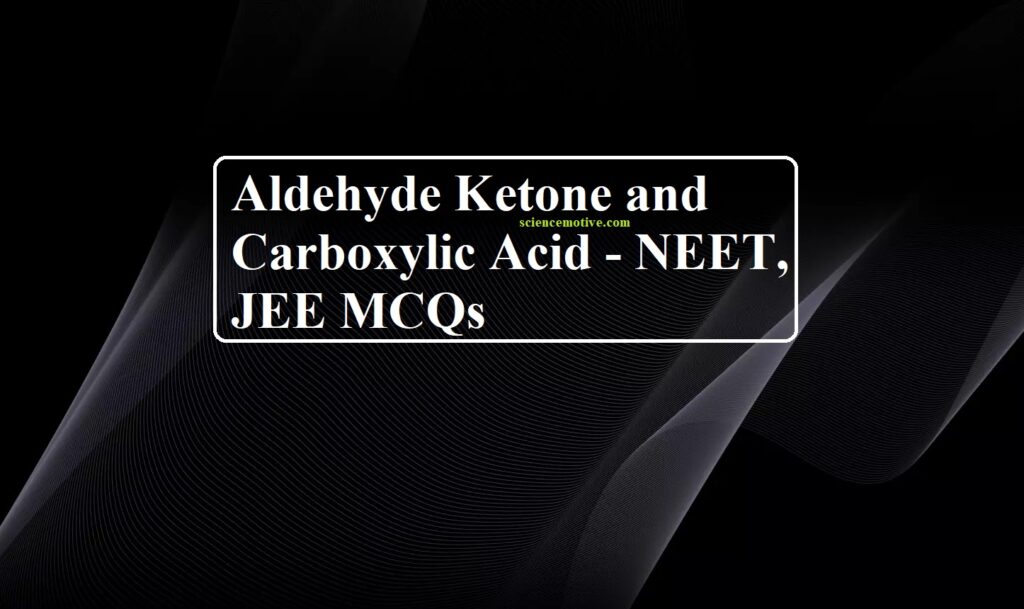Aldehyde Ketone and Carboxylic Acid
Aldehyde Ketone and Carboxylic Acid
Que 1. The IUPAC name of the compound having the molecular formula
Cl3C – CH2CHO is
(a) 3, 3, 3- trichloropropanal
(b) 1, 1, 1- trichloropropanal
(c) 2, 2, 2- trichloropropanal
(d) Chloral
Ans 1. (a) 3, 3, 3- trichloropropanal
Que 2. The IUPAC name of CH3COCH(CH3)2 is
(a) 2-methyl-3-butanone
(b) 4-methylisopropyl ketone
(c) 3-methyl-2-butanone
(d) Isopropylmethyl ketone
Ans 2. (c) 3-methyl-2-butanone
Que 3. Identify compound X in the following sequence of reactions:

Ans 3. (c)
Reason: The following reaction takes place

Que 4. In the following reaction, product P is
 (a) RCH2OH
(a) RCH2OH
(b) RCOOH
(c) RCHO
(d) RCH3
Ans 4. (c) RCHO
Que 5. which of the following is not soluble in NaHCO3?
(a) 2,4,6 Trinitrophenol
(b) Benzoic acid
(c) o- nitrophenol
(d) Benzenesulphonic acid
Ans 5. (c) o- nitrophenol
Aldehyde Ketone and Carboxylic Acid
Que 6. CH3CHO & C6H5CH2CHO can be distinguished chemically by
(a) Benedict’s test
(b) Iodoform test
(c) Tollen’s reagent test
(d) Fehling’s solution test
Ans 6. (b) Iodoform test
Que 7. The product formed by the reaction of an aldehyde with primary amine is
(a) Carboxylic acid
(b) Aromatic amine
(c) Schiff’s base
(d) ketone
Ans 7. (c) Schiff’s base
Que 8. Which one of the following can be oxidized to the corresponding carbonyl compound?
(a) 2-hydroxy-propane
(b) Ortho-nitrophenol
(c) Phenol
(d) 2-methyl-2 hydroxy-propane
Ans 8. (a) 2-hydroxy-propane
Reason: Carbonyl compounds (aldehydes and ketones) are obtained by the oxidation of 1° and 2° alcohols respectively. Among the given options, only (a) is 2° alcohol hence it can be oxidized to the ketone.

Que 9. Which one of the following on oxidation gives a ketone?
(a) Primary alcohol
(b) Secondary alcohol
(c) Tertiary alcohol
(d) All of these
Ans 9. (b) Secondary alcohol
Reason: Secondary alcohols on oxidation give ketones whereas Primary alcohols from aldehydes.

Aldehyde Ketone and Carboxylic Acid
Que 10. What is formed when primary alcohol undergoes catalytic dehydrogenation?
(a) Aldehyde
(b) Ketone
(c) Alkene
(d) Acid
Ans 10. (a) Aldehyde
Reason: 1° Alcohol on catalytic dehydrogenation give aldehydes.

Que 11. Ketones [RCOR1] where R = R1 = alkyl group. It can be obtained in one step by
(a) oxidation of tertiary alcohol
(b) the reaction of acid halide with alcohols
(c) hydrolysis of esters
(d) oxidation of primary alcohol.
Ans 11.
Que 12. The catalyst used in Rosenmund’s reduction is
(a) HgSO4
(b) Pd/BaSO4
(c) anhydrous AlCl3
(d) anhydrous ZnCl2
Ans 12. (b)
Reason: The catalyst used in Rosenmund reduction is Pd/BaSO4. Rosenmund reduction is used for the reduction of acid chloride.

Aldehyde Ketone and Carboxylic Acid
Que 13. The oxidation of toluene to benzaldehyde by chromyl chloride is called
(a) Rosenmund reaction
(b) Wurtz reaction
(c) Etard reaction
(d) Fittig reaction
Ans 13. (c) Etard reaction
Que 14. The correct statement regarding a carbonyl compound with a hydrogen atom on its alpha carbon is
(a) a carbonyl compound with a hydrogen atom on its alpha-carbon rapidly equilibrates with its corresponding enol and this process is known as carbonylation
(b) a carbonyl compound with a hydrogen atom on its alpha-carbon rapidly equilibrates with its corresponding enol and this process is known as keto-enol tautomerism
(c) a carbonyl compound with a hydrogen atom on its alpha-carbon never equilibrates with its corresponding enol
(d) a carbonyl compound with a hydrogen atom on its alpha-carbon rapidly equilibrates with its corresponding enol and this process is known as aldehyde-ketone equilibration.
Ans 14. (b) a carbonyl compound with a hydrogen atom on its alpha-carbon rapidly equilibrates with its corresponding enol and this process is known as keto-enol tautomerism
Que 15. The correct structure of the product ‘A’ formed in the reaction
 Ans 15. (b)
Ans 15. (b)

Que 16. The correct order of increasing acidic strength is
(a) Phenol< Ethanol < Chloroacetic acid< acetic acid
(b) Ethanol < Phenol < Chloroacetic acid< acetic acid
(c) Ethanol< Phenol < acetic acid < Chloroacetic acid
(d) acetic acid < Chloroacetic acid< Ethanol< Phenol
Ans 16. (c ) Ethanol< Phenol < acetic acid < Chloroacetic acid
Que 17. which compound will not reduce Fehling’s solution?
a) Methanal
b) Ethanal
c) Trichloroethanal
d) Benzaldehyde
Ans 17. d) Benzaldehyde
Assertion Reason type Question
a statement of Assertion followed by a statement reason is given. Choose the correct options out of the following choices.
(A) Both assertion and reason are correct statements, and the reason is the correct explanation of the assertion.
(B) Both assertion and reason are correct statements, but the reason is not the correct explanation of the assertion.
(C) Assertion is correct, but the reason is the wrong statement.
(D) Assertion is wrong, but the reason is a correct statement
Que 18. Assertion: Compounds containing –CHO group are easily oxidized to corresponding carboxylic acids.
Reason: Aldehydes contain a C-H bond that cannot be easily broken.
Ans 18. (c)
Que 19. Assertion: aromatic aldehyde & formaldehyde undergo Cannizzaro reaction.
Reason: aromatic aldehydes are as reactive as formaldehyde
Ans 19. (D)
Que 20. Assertion: Formaldehyde is a planar molecule.
Reason: It contains sp2 hybridized carbon atom.
Ans 20. (A)
Que 21. Assertion: Compounds containing –CHO group are easily oxidized to corresponding carboxylic acids.
Reason: Carboxylic acids can be reduced to alcohol by treatment with LiAlH4.
Ans 21. (B)
Aldehyde Ketone and Carboxylic Acid



